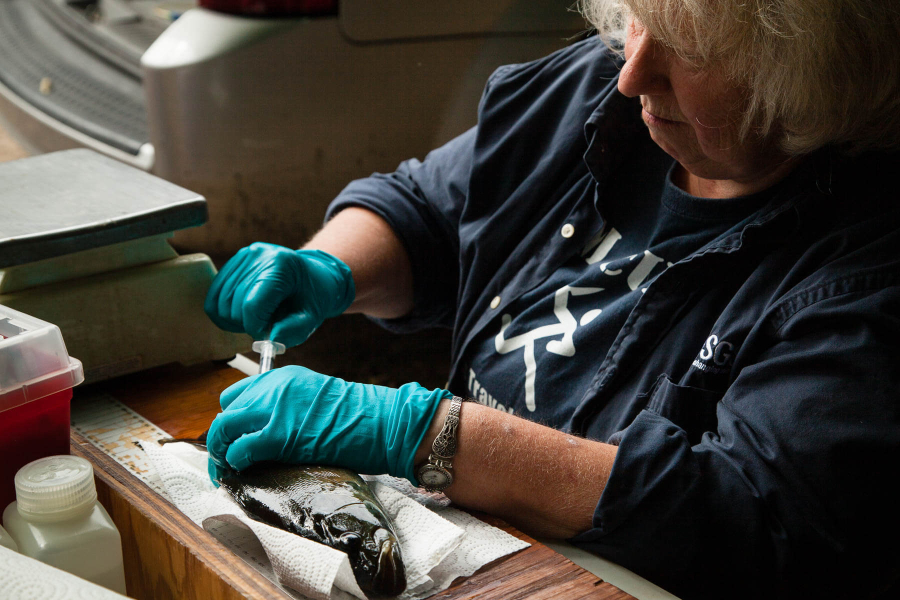Tracing the “Forever Chemical” in the Chesapeake Bay

Practically everywhere you look, you’ll find a class of chemicals that are so persistent that scientists have dubbed them, “The Forever Chemical.” The technical name is per- and polyfluoroalkyl substances (PFAS), and it’s a class of more than 4,700 man-made chemicals that are found in a wide range of consumer and industry products, from non-stick cookware and water-repellent textiles to fire suppressants used on military bases and airports.
In many ways, PFAS are one of man’s greatest inventions. The chemicals make products more resistant to high temperature, reduce friction and repel water and oil; basically, all of the things that make products safer and easier to use. On the other hand, PFAS are also extremely sturdy, which means they don’t break down easily, if at all, and can accumulate over time in the environment.
PFAS in the Chesapeake Bay watershed
Here in the Chesapeake Bay watershed, it’s important understand how toxins such as PFAS impact our water and land. For example, low traces of PFAS can be found in food and drinking water due to contaminated soil and water, although this is generally localized and associated with a specific facility, such as an oil refinery, military base or airfield. In 2018, the Environmental Protection Agency released a PFAS action plan that outlines steps to address PFAS and protect human health. Currently, the agency has set PFAS health advisory levels at 70 parts per trillion, which is the maximum amount water can contain while still being considered safe to drink.
When it comes to fish and shellfish, we are only beginning to determine how PFAS impact the health of these organisms and the water they live in. Recent analyses by the U. S. Geological Survey indicates that low levels of PFAS were found in the blood plasma of smallmouth bass in Antietam Creek, Maryland. Additional samples will be taken and analyzed to better understand to what extent it is impacting smallmouth bass. According to a Bay Journal article, sampling done by the Maryland Department of the Environment detected no PFAS in oysters collected from rivers and creeks near the Naval Air Station along the Patuxent River, and that surface waters sampled where those oysters were growing registered what officials described as “very low” levels of the chemicals.
While research indicates that PFAS isn’t currently an immediate threat to human health, more is needed to determine if this is definitive. This is especially true because of how difficult PFAS are to trace and the magnitude of their presence. Although the United States has voluntarily phased out some PFAS chemicals, including PFOA (perfluorooctanoic acid) and PFOS (perfluorooctane sulfonate), which are used in oil and heat-repellent products, manufactures have invented other chemicals to take their place. For example, the GenX chemicals were invented primarily as a replacement for other chemicals used in fire suppressants, and are now found in water sources and air emissions in some areas.
Chesapeake Bay Program tackles toxic contaminants
The Chesapeake Bay Program’s Toxic Contaminant Workgroup is dedicated to keeping the Bay and its rivers free of the effects of toxic contaminants such as PFAS. The workgroup strives to meet the goals and outcomes outlined in the Chesapeake Bay Watershed Agreement, which includes a Policy and Prevention and Research outcomes.
One area of research that the Toxic Contaminants Research outcomes focuses on is “contaminants of emerging concern”, which PFAS falls under. Recently, the Chesapeake Bay Program’s Management Board tasked the workgroup with identifying leads for PFAS research from each of the seven watershed jurisdictions (Delaware, the District of Columbia, Maryland, New York, Pennsylvania, Virginia and West Virginia), in order to better coordinate PFAS science and research across the watershed. These findings will help guide the focus of the workgroup in the coming years.
Another focus of the Toxics Contaminants Workgroup over the past few year has been highlighting fish consumption advisories around the watershed. Each jurisidiction releases an advisory in order to provide recommendations on whether or not to avoid or limit consumption of certain fish species from specific bodies of water. These advisories mainly highlight PCBs and mercury, but may eventually include PFAS as we learn more about the chemicals and are able to effectively measure them in the water.
- Maryland: https://mde.maryland.gov/programs/Marylander/fishandshellfish/Pages/fishconsumptionadvisory.aspx
- Virginia: https://www.vdh.virginia.gov/environmental-health/public-health-toxicology/fish-consumption-advisory/
- District of Columbia: https://doee.dc.gov/service/fishdc
- Pennsylvania: https://www.dep.pa.gov/Business/Water/CleanWater/WaterQuality/FishConsumptionAdvisory/Pages/default.aspx
- New York: https://www.health.ny.gov/environmental/outdoors/fish/health_advisories/
- Delaware: https://dnrec.alpha.delaware.gov/fish-wildlife/fishing/consumption-advisories/
- West Virginia: https://node2.wvdhhr.org/scales/client/index.html

Comments
There are no comments.
Thank you!
Your comment has been received. Before it can be published, the comment will be reviewed by our team to ensure it adheres with our rules of engagement.
Back to recent stories